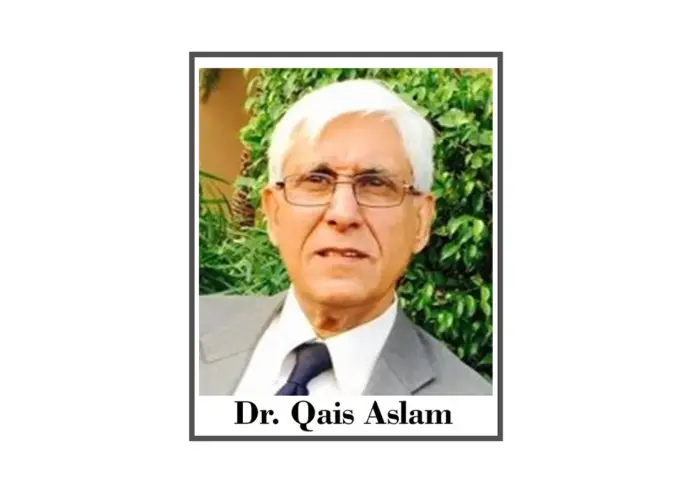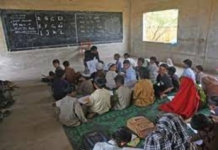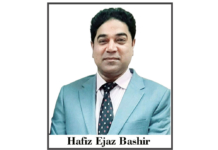Education is key to making a person capable in expressing his or her individual choices and becoming empowered towards economic and political decision making in their household, community and the country. Education not only enhances intellectual capabilities of a person, but also if proper training is given, enhances their skills, productivity and income earning capabilities.
“In ancient Egypt literacy was concentrated among an educated elite of scribes that served the temples and the pharos. Only people from certain backgrounds were allowed to train to become scribes”, “In ancient India, education was mainly imparted through the Vedic and Buddhist education system”. “In China the first education system was created in Xia dynasty (2076–1600 BC). During Xia dynasty, the government had built schools to educate aristocrats about rituals, literature and archery (important for ancient Chinese aristocrats). During Shang dynasty (1600 BC to 1046 BC), normal people (farmers, workers etc.) were also given rough education. In that time, aristocrats’ children studied in government schools”. “In the 4th and 5th Century BC, there were private schools in Greek City States and Public schools in Sparta, while the first schools in Ancient Rome arose by the middle of the 4th century BC”. “The history of education in Japan dates back at least to the 6th century.” “In Medieval Europe, during the late medieval period, students attending town schools were usually between the ages of seven and fourteen”. “The first medieval institutions generally considered to be universities were established in Italy, France, and England in the late 11th and the 12th centuries for the study of arts, law, medicine, and theology”. In the Islamic world, “The University of al-Qarawiyyin located in Fes, Morocco is the oldest existing, continually operating and the first degree awarding educational institution in the world according to UNESCO and Guinness World Records and is sometimes referred to as the oldest university”. “The Islamic Mosque school (Madrasah) taught the Quran in Arabic and did not at all resemble the medieval European universities. In the 9th century, Bimaristan medical schools were formed in the medieval Islamic world, where medical diplomas were issued to students of Islamic medicine who were qualified to be a practicing Doctor of Medicine.[57] Al-Azhar University, founded in Cairo, Egypt in 975, was a Jami’ah (“university” in Arabic) which offered a variety of post-graduate degrees, had a Madrasah and theological seminary, and taught Islamic law, Islamic jurisprudence, Arabic grammar, Islamic astronomy, early Islamic philosophy and logic in Islamic philosophy. Under the Ottoman Empire, the towns of Bursa and Edirne became major centers of learning.” “In the 15th and 16th centuries, the town of Timbuktu in the West African nation of Mali became an Islamic center of learning with students coming from as far away as the Middle East”. (Source: https://en.wikipedia.org/wiki/History_of_education#:~:text=The%20first%20education%20system%20was,(farmers%2C%20workers%20etc.)
According to UPSC Notes, the main agents of formal education system in British India were (a) East India Company and later The British Government who needed an educated aristocratic class to serve the government and collect land revenue as well as become a link between local languages and English; (b) Christian Missionaries, who established many schools with education only being a means to an end which was Christianizing and ‘civilizing’ the natives;. and (c) Indian Intellectuals and Reformers who believed that to keep up with times, a modern educational system was needed to spread rational thinking and scientific principal. In 1781 Warren Hasting established the Calcutta Madrassa and in 1791 Jonathan Duncan established a Sanskrit Colledge in Varanasi. The Charter Act of 1813 was the first step towards education being made an objective of the government. “In 1835, it was decided that western sciences and literature would be imparted to Indians through the medium of English”. Macaulay though his doctrine of education for Indians “wished to create a class of Indians who were Indian in color and appearance but English in taste and affiliation”. Source: https://byjus.com/free-ias-prep/ncert-notes-education-system-in-india-during-british-rule/#:~:text=The%20Charter%20Act%20of%201813,permission%20to%20come%20to%20India.) Sir Syed Ahmed Khan was an Indian Muslim reformer, philosopher, and educationist in nineteenth-century British India. who advocated the teaching to Indian Muslims through English. “He was one of those early pioneers who recognized the critical role of education in the empowerment of the poor and backward Muslim community.”
Formal education in modern times is the outcome of the invention of printing press and paper that led towards mass printing of textbooks and establishing schools in order to serve the rapid influx of Industry in the western world, especially England. The main purpose of school education was to create a class of office workers and human resource that could be equipped with financial, legal and management skills in order to link the entrepreneurial decisions with labor productivity cost effectively and efficiently. Researches show that nations where there is mass education for liberal arts, performing arts, philosophy, communication skills IT, and scientific know how have grown more rapidly than those nations that till today have a policy of ‘apartheid’ in education – a few state-of-the-art elite schools for the rich, sub-standard schools for the children of the poor that lack proper facilities, teachers and textbooks and then also, millions of children in Pakistan are out of school.
“Education for Sustainable Development (ESD) is a key element of the 2030 Agenda for Sustainable Development. Its aims form one of the targets of the Sustainable Development Goal on education SDG 4.7 and it is considered a driver for the achievements of all 17 SDGs” (UNESCO, 2021). All education and teaching should give productivity & creativity to students; Communication skills and IT skills to students; Scientific knowledge and Analytic skills to the students and Teamwork as well as Citizenship Behaviours that cater for human rights, legal environment and protecting of natural & man-made assets of the country. Therefore, a thorough knowledge about needs and direction of SDGs for a more sustainable and viable world.
In Pakistan after 75 years of independence, there are a small percentage of the population that can be considered highly educated where many a child do not go to school and millions more that drop out before reaching class 6. The public schooling system lacks schools, teachers, textbooks, methodology and even infrastructure. At the same time the policy makers claim that the nation’s economy and population would reach G-20 nations in a short span of time. This system of education of Pakistan has multiple issues like unqualified or untrained in modern teaching methodologies teachers, substandard textbooks, and outmoded teaching methodologies, also as most of these schools lack building, infrastructural, toilet, transport etc. facilities, therefore dropout ration in these schools is very high. Most of Government (Public Sector) schools as well as private schools with low fee structures lack qualified teachers, lack teaching materials, lack teaching methodology and lack quality textbooks and even proper financing.
According to Economic Survey 2021-2022 of Pakistan total enrolment in the country In Primary classes total enrolment was 24.6 million, out of which 11.1 million (45.1%) were girls. In Middle classes total enrolment was 8.0 million, out of which 3.6 million (45.0%) were girls. In High school total enrolment was 4.2 million, out of which 1.9 million (45.2%) were girls, and In High Secondary-Inter classes total enrolment was 1.8 million, out of which 0.8 million (44.4%) were girls (On average 45% of all enrolments at all levels were girls. Data shows that while 24.6 million children were enrolled in primary classes in the country, in 2020-2021, only 1.8 million reached high secondary levels. Therefore, question can be asked, why 16.6 million children dropped out before reaching middle school and another 3.8 million dropped out before reaching high school and only 1.8 million passed their metric exam to reach intermediate classes. If these 16.6 million children had also passed their metric exam, the quality of labor force in the country would have been different than what it is today with a large percentage of disguised unemployment where the minimum wage is PK Rs. 25 thousand a month (or US $ 4 a day) and the marginal productivity of labor is near zero.
According to World Bank Report 2023 on Human Capital, “Low human capital investments will limit the realization of Pakistan’s ambition to become an upper-middle-income country by 2047”. “Pakistan’s Human Capital Index (HCI) value of 0.41 is low in both absolute and relative terms; lower than the South Asia average of 0.48, with Bangladesh at 0.46 and Nepal at 0.49.” “If Pakistan continues on its current trajectory in human capital development, its GDP per capita would grow overall by a mere 18 per cent through 2047. According to the Report, “Human capital makes up 61pc of Pakistan’s wealth, yet its levels of human capital are among the world’s lowest.” The Report suggests that “if Pakistan can boost human capital investments and its HCI value to the level of its peers, per capita could grow by 32pc. But if Pakistan improves both its human capital and its use of human capital, bringing adults into employment outside farming, GDP per capita could rise by 144pc, eight times more than under business as usual.” (Source: https://www.dawn.com/news/1745428/pakistan-makes-inadequate-investments-in-human-capital-wb)
Our children are our future. If they are educated, and skilled in modern productive techniques as well as equipped with international work habits of eight hours honest and intelligent work, this country would regain its position in nations with spurred GDP growth and would not have to beg for much needed dollars from international organizations or other friendly countries at hard conditions. Now is the time when reports after reports are pointing towards educating the future generations into viable scientific and skilled based education that can produce productive workforce and entrepreneurs. If we do not revamp our present education system, shed a few unnecessary subjects that have no utility for achieving lifetime economic goals, we would be left behind from those nations who have realized that mass scientific and skill-based education is the key for economic growth and development. UK, USA, EU, Japan, China, Russia are all nations that have not compromised on educating their population and are now considered developed nations, irrespective of their political or economic systems. Only nations that have created apartheid in education like Pakistan are lagging behind as developing nations where the educated are attracted towards the greener pastures of the industrial North and only unskilled and less educated are eft behind to man the economic, political and social fronts at home. This situation should change now by revamping and reforming our education system towards a wholistic approach towards creating skillful hands and analytic brins of all our children irrespective of their gender or economic status. Only with highly developed human resource can we turn around the adverse effects of the multiple crisis that have descended upon Pakistan in 2023.







